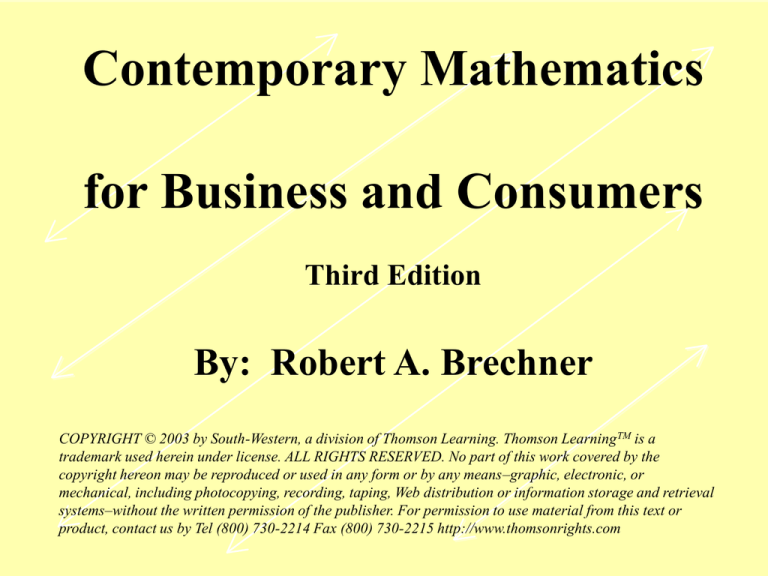
Contemporary Mathematics
for Business and Consumers
Third Edition
By: Robert A. Brechner
COPYRIGHT © 2003 by South-Western, a division of Thomson Learning. Thomson Learning TM is a
trademark used herein under license. ALL RIGHTS RESERVED. No part of this work covered by the
copyright hereon may be reproduced or used in any form or by any means–graphic, electronic, or
mechanical, including photocopying, recording, taping, Web distribution or information storage and retrieval
systems–without the written permission of the publisher. For permission to use material from this text or
product, contact us by Tel (800) 730-2214 Fax (800) 730-2215 http://www.thomsonrights.com
Chapter 14
Mortgages
Copyright © 2003 by South-Western
Chapter 14, Mortgages
Section I Mortgages – Fixed Rate
Adjustment
14-1 Calculating the monthly payment and total
interest paid on a fixed rate mortgage.
14-2 Preparing a partial amortization schedule of
a mortgage.
14-3 Calculating the monthly PITI of a mortgage
loan.
14-4 Understanding closing costs and calculating
the amount due at closing.
Chapter 14, Mortgages (Cont.)
Section I Mortgages - Fixed Rate and
Adjustable-Rate (Cont.)
14-5 Calculating the interest rate of an adjustablerate mortgage (ARM).
Section II Second Mortgages – Home
Equity Loans and Lines of Credit
14-6 Calculating the potential amount of credit
available to a borrower.
14-7 Calculating the housing expense ratio and the
total obligations ratio of a borrower.
Section I, Mortgages- Fixed Rate and AdjustableRate
14-1 Calculating the payment and Total Interest Paid on a Fixed-Rate
Mortgage
Steps to Find the Monthly Mortgage Payment by Using an
Amortization Table, and Total Interest:
Step 1. Find the number of $1000s financed by
Number of $1000 financed = Amount financed
1000
Step 2. Using table 14-1, locate the table factor, monthly
payment per $1000 financed, at the intersection of the number
of years column and the interest rate row.
Step 3. Calculate the monthly payment by
Monthly payment = Number of $1000s financed x Table factor
Everybody’s Business
“Remember that the table values represent
monthly payment “per $1000” of the monthly
payment, you must first determine the number of
$1000s being financed, then multiply that figure
by the table factor.
14-2 Preparing a Partial Amortization Schedule of a Mortgage
Steps to Create an Amortization Schedule for a Loan :
Step 1. Use table 14-1 to calculate the monthly amount of the
monthly payment
Step 2. Calculate the amount of interest for the current month using I
= PRT, where P is the current outstanding balance of the loan, R is
the annual rate, at T is 1/12.
Step 3. Find the portion of the payment used to reduce principal by
Portion of payment reducing principal = Monthly payment - Interest
Step 4. Calculate the outstanding balance of the mortgage loan by
Outstanding balance = Previous balance – Portion of pmt. Reducing
principal
14-2 Preparing a Partial Amortization Schedule of a
Mortgage
Steps to Create an Amortization Schedule for a
Loan :
Step 5. Repeat Steps 2, 3, and 4 for each
succeeding month and enter the values on a
schedule labeled as follows:
Payment Monthly Monthly Portion Used
Loan
Number Payment Interest
Balance
to Reduce Loan
Everybody’s Business
As a result of declining mortgage rates in recent years, a
record 68% of families own their own homes today. That
amounts to nearly 72 million households.
Purchasing and financing a home is one of the most
important financial decisions a person will ever make.
Substantial research should be done and care taken in
choosing the correct time to buy, the right property to buy,
and the best financial offer to accept.
Everybody’s Business
Typically, over the years of a mortgage, property
taxes and insurance premiums rise. When this
happens, the lender must increase the portion set
aside in the escrow account by increasing the taxes
and insurance parts of the monthly payment.
14-3 Calculating the Monthly PITI of a Mortgage
Loan
Steps to Calculate the PITI of a Mortgage:
Step 1. Calculate the principal and interest portion, PI, of the
payment as before using the amortization table, Table 14-1
Step 2. Calculate the monthly tax and insurance portion, TI:
Monthly TI = Estimated property tax + Hazard insurance
12
Step 3. Calculate the total monthly PITI:
Monthly PITI = Monthly Pi + Monthly TI
Section II, Second Mortgages – Home equity Loans
and Line of Credit
14-6 Calculating the Potential Amount of Credit Available to a
Borrower
Steps to Calculate the Potential Amount of Credit:
Step 1. Calculate the percentage of appraised value by
Percentage of appraised value = Appraised value x Lender’s percentage
Step 2. Find the potential amount of credit available by
Potential credit = Percentage of appraised value – First mortgage
balance
14-7 Calculating the Housing Expense Ratio and the
Total Obligations Ratio of a Borrower
Housing expense ratio = Monthly housing expense (PITI)
Monthly gross income
Total obligations ratio = Total monthly financial obligations
Monthly gross income
Chapter 14, Mortgages – Fixed Rate and
Adjustable Rate
Real estate
Federal Housing Administration
GI loan
Private mortgage insurance
Mortgage discount points
Level-payment plan
PITI
Title or deed
Settlement or closing statement
Index rate
Teaser rate
Overall cap
Mortgage
VA mortgage
Conventional loans
Adjustable-rate mortgage
Closing
Amortization schedule
Escrow account
Closing costs
Adjustment period
Margin
Interest-cap
Initial interest cap
Chapter 14
Monthly payment = Number of $1,000s financed x Table
factor
Total interest = Monthly
payment
x
Number of
Amount
–
payments
financed
Monthly taxes & insurance (TI) =
Estimated property tax + Hazard ins.
12
Monthly PITI = Monthly PI + Monthly TI
Copyright © 2003 by South-Western
Chapter 14
ARM(Calculated interest rate) = Index rate + Lender’s
margin
ARM(Max. rate per adjustment period) = Previous + Periodic
rate
cap
ARM(Max. overall rate) = Initial rate + Overall cap
Percent of appraised value = Appraised
value
x
Lender’s
Percentage
Copyright © 2003 by South-Western
Chapter 14
Second mortgage potential credit =
Percentage of appraised value - First mortgage balance
Housing expense ratio = Monthly housing expense (PITI)
Monthly gross income
Total obligations ratio =
Total monthly financial obligations
Monthly gross income
Copyright © 2003 by South-Western






